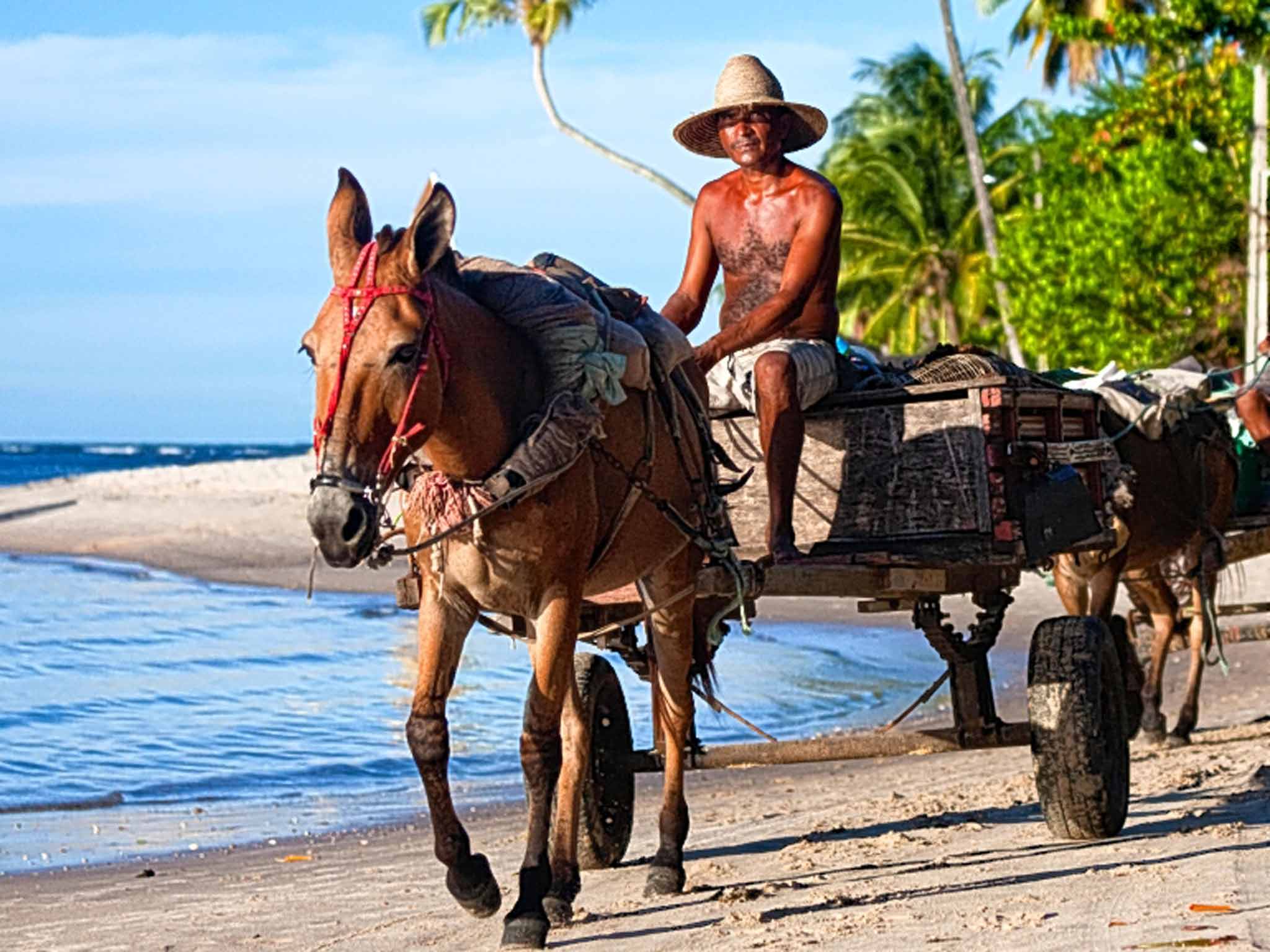Boipeba, Brazil: Life moves at an easy pace on this car-free tropical island
So far, Boipeba's low-key development has been carefully monitored, but that may change

It came as a shock suddenly to see a vehicle bump along the sandy track. There weren't supposed to be any cars on the island, let alone this bulky 4x4. Then, as it came closer, I saw it was painted with palm-trees and the word “ambulancia”. So, with the norm of tractors, mule-carts and wheel-barrows preserved, the ambulance disappeared amid the palms.
Boipeba, a 12-kilometre wedge of jungle, mangrove and powdery beaches, lies south of Salvador de Bahia, Brazil's first colonial capital. The sprawling city still fizzes with West African culture that arrived with slaves in the 16th century, and a few nights at a smart pousada in the old quarter, Pelourinho, gave me a rousing introduction. Batucadas (drumming bands) roamed the streets, while acrobatic capoeira kids spun and somersaulted on the magnificent main square, Terreiro de Jesus. The sensory immersion was intensified by a general nocturnal build-up to Brazil's largest carnival, just a week away. Enthralling, but hardly relaxing.
So, when a five-hour journey by ferry, bus then speedboat finally deposited me at the jetty of paradise, who was I to complain? Palm trees nodded dutifully, a paved street snaked uphill past clumps of bougainvillea, hibiscus, gaudily-painted houses and little eateries, and a pretty Baroque church overlooked the central square of Velha Boipeba. Spotlit by the late afternoon sun, groups in T-shirts and shorts hung out chatting on porches, or kicked a football on the green. Such sweetness, light and low decibels made a very seductive start.
I picked the pousada, O Ceu de Boipeba, mainly for its spectacular views. But the catch was – in the absence of cars – getting there. O Ceu (“the sky”) crowns the island's highest point, and even as the slender barrow-boy pushing my bag ran up the steep rutted path, I struggled in the tropical sun. Once I arrived, those views did not disappoint, sweeping over swaths of jungle, an endless white beach and the gentle Atlantic waves. Soon, caipirinha in hand, I was watching a sublime sunset.
Boipeba derives its name from mboi pewa, which is Tupy Indian for “flat snake”. I didn't spot any, but did see a boa constrictor wrap itself lazily around a tree. That was thanks to the sharp eyes of Roni, a cheerful man whose house and tiny restaurant, run by his wife, overlook my favourite beach, a 10-minute walk downhill through shady jungle that flickered with butterflies. Praia Boca da Barra was often deserted, despite being a pristine, kilometre-long curve of sand fringed by palm trees and beach almonds, which ended at the main village, via the odd coconut-seller. In the other direction, beyond a forested headland, unfolded Praia de Tassimirim, equally empty and blissful. And this was high season.
One day, I set off on the dazzling beach trek to Morere, a smaller village that has become a secondary hub for charming pousadas and restaurants. At low tide, a cluster of natural pools formed by the coral reef lures snorkellers, but I soon gathered my timing was off. On the way there I had only just made it across an estuary before the tide rushed in, reducing Morere beach to a mere ribbon of sand. But who cared? That left more time for fresh lobster and delectable moqueca of coconut milk-doused crab meat before I collapsed into a tractor-trailer for the ride back home.
For centuries Boipeba's inhabitants lived on fishing (crab, lobster, clams, fish, prawns), as well as tropical fruits (the ubiquitous coconut, mangoes, cashew nuts and pear-like mangaba). Yet although I was spoilt by luscious, ever-changing tropical fruit during gargantuan breakfasts, fish was mysteriously absent, for with the growth of tourism, fishing boats are more often used for snorkelling trips, rides to oyster restaurants, or simply as water-taxis. But not only that; on one festive day, I watched a flotilla of boats decked with flowers and balloons transport dozens of white-clad villagers out to sea. They were carrying a statue of Yemanja, the Yoruba goddess of the ocean, back to her watery home.
So far, Boipeba's low-key development has been carefully monitored, but that may change. “An Italian who owns huge tracts of land round here plans to develop it,” explained Jesus, manager of O Ceu de Boipeba. “And because he promises electricity and roads, some people welcome that. Then there's another project for a big resort of villas and a golf-course near Morere.”
Somehow that type of glitz does not chime with the lotus-eating perfection of this little-known tropical island, with its harmonious community seemingly bewitched by the beauty, peace and gentle pace. Long may it last.
Getting there
TAP (0345 601 0932; flytap.com) flies to Salvador from Heathrow, Gatwick and Manchester, via Lisbon, from £617 return. Bahia Terra (00 55 75 3653 6017; boipebatur.com.br) offers flights from Salvador to Tinharé, Boipeba's neighbouring island, with speedboat transfer, from £98 one way. Journey Latin America (020 8600 1881; journeylatinamerica.co.uk) has a 10-day holiday to Brazil with three nights' B&B in Salvador and six nights' B&B in Boipeba, transfers, and flights from £2,336pp.
Staying there
O Ceu de Boipeba (00 55 75 9908 8995; oceudeboipeba.com). B&B doubles from R320 (£55).
More information
Subscribe to Independent Premium to bookmark this article
Want to bookmark your favourite articles and stories to read or reference later? Start your Independent Premium subscription today.

Join our commenting forum
Join thought-provoking conversations, follow other Independent readers and see their replies